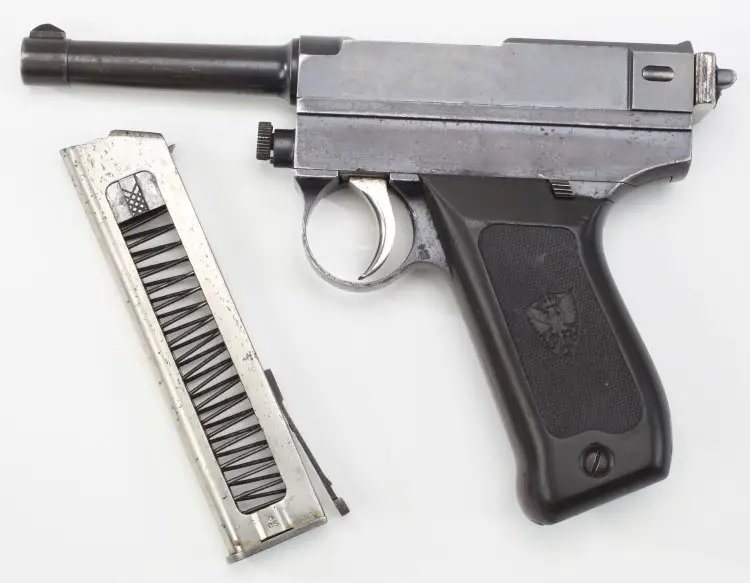The first semi-automatic pistol to equip the Italian Army, the Glisenti was a mediocre pistol that acquired the nickname “Luger dei poveri” meaning the Luger of the poor. Its replacement started in 1915 and also saw action in WW2, equipping second line units.

Glisenti Model 1910
At the end of the 19th century, the small arms market saw a major revolution with the appearance of the first semi-automatic pistols: the Borchard C93 and the Mauser C96. The latter became an iconic handgun and a commercial success. The whole world started to rush into the development of new semiautomatic pistols, and so did the Italians.
Abiel Bethel Revelli was a brilliant arm designer who later became famous for machine gun designs like the Fiat-Revelli 1914, the SMGs Villar Perosa 1915 and 1918. However, at the beginning of the 20th century, he started to develop a semi-automatic pistol working with the Società Siderurgica Glisenti, a small manufacturer from Lombardy. In 1905, the company filled a patent for a new weapon named Pistola Automatica Glisenti or Glisenti Modello 1906, firing a 7,65mm cartridge. At this time, army officers were pretty much free to buy their sidearms, some of them purchased the Glisenti to replace pistols like the Revolver Bodeo 1889 or other similar weapons. In this period, the Glisenti factory produced around 3,000 of these pistols.
In 1907, the owner of the Glisenti factory died and his heirs decided to sell the weapons production line of the company. It was sold (together with the Glisenti mod 1906 patent) to Metallurgica Bresciana Tempini (MBT).
In 1908, the Austro-Hungarian army adopted the Semi-automatic Steyr M1907. In Germany, the new Luger P08 appeared, this pistol fired the newly designed 9mmx19mm parabellum cartridge. In this context, the Regio Esercito decided to replace its old revolvers. In 1909, the army issued a specification for a semi-automatic pistol firing the 9x19mm parabellum cartridge. MBT saw the opportunity to participate in the procurement with the Glisenti mod. 1906, re-chambered for the 9mm cartridge. They did so to avoid redesigning from zero a new weapon and sought to exploit the recently acquired patent of the Glisenti by re-chambering the pistol. However, the big problem was that it still could not resist the power of a 9mm parabellum cartridge. The reason being that the Glisenti had been designed for a different (smaller) kind of ammunition.
The solution was the reduction of the black powder content in the cartridge, thus limiting the power and vibration of the shot. This new version of the Glisenti became known as Modello 1910. However, the result was a pistol firing a weaker cartridge if compared to its contemporaries.
The presence of Revelli in the procurement evaluation committee of the army, in addition to non-Italian (Colt and Mannlicher) or non-adequate competitors (the Vetterli pistol), secured the selection of the Pistola Automatica Glisenti mod.1910.
Until 1920, MBT produced between 30,000 and 33,000 of mod.1910, these pistols went to substitute the Bodeo revolvers of the army and the Carabinieri, as well as the Mauser M99 of the Regia Marina. The first time they saw action was during the Italo-Turkish War of 1912 and were fully in place by the start of World War One. However, the poor ballistic qualities of the Glisenti mod.1910 soon started to emerge and from 1916 onwards, the Glisenti was progressively replaced by the Beretta 1915.
There was also a logistical-security problem, the Glisenti cartridge could be easily mistaken with standard 9mm parabellum, firing one of these cartridges would have damaged the pistol or even injured the shooter.
The production was progressively phased out and ceased by 1920. However, the Glisenti mod. 1910 remained in service within several Carabinieri and second-line army units. The adoption and mass production from 1934 of the famous Beretta M34 did not make the Glisenti disappear either. It was still in service until the Second World War, dispersed among some garrison units, colonial troops, costal divisions and Carabinieri units. Officially it was taken out of service in 1945, scoring almost 40 years of service.
Sources:
Books
Le cinque vite della Glisenti 1910, Emanuele Marcianò ed Adriano Simoni, Ermanno Albertelli Editore
Web
La Glisenti 1910..civile, www.armietiro.it
